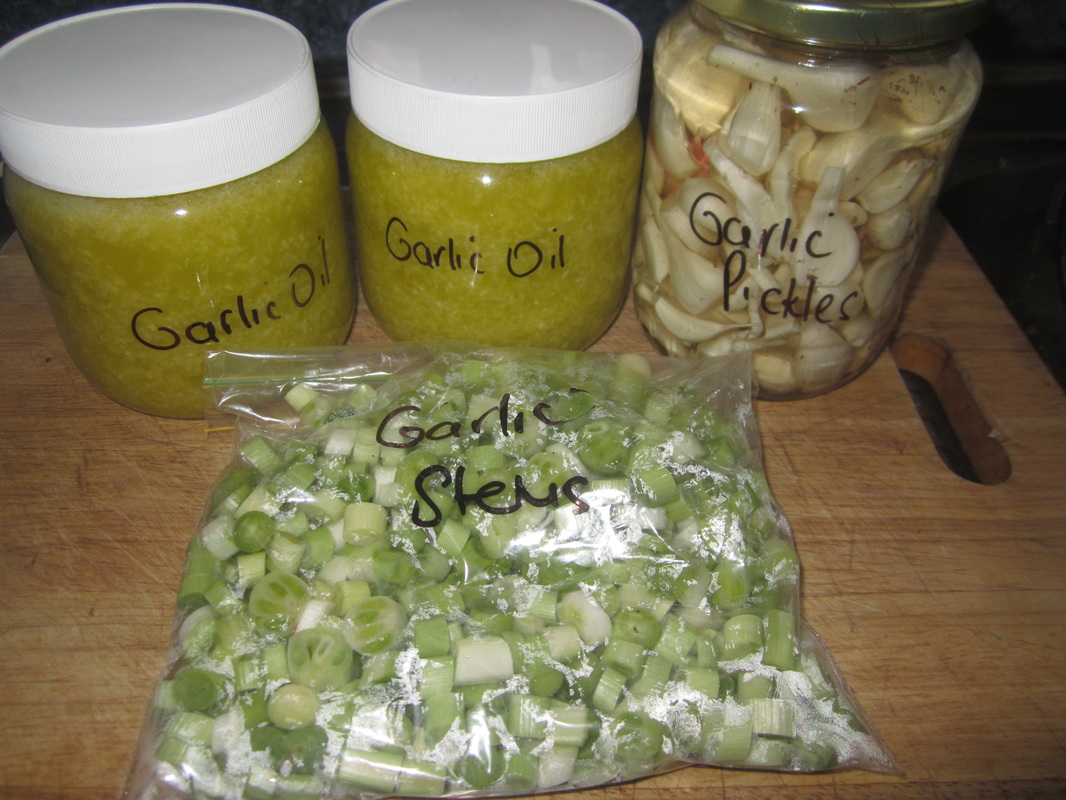Garlic stores well whole or braided - for instructions on how to do that, see HERE. There are other ways to preserve garlic too. Here are some of them:
This year, I have chosen to chop up the green stalks and freeze them in a ziplock bag - I will add small handfuls to various dishes I cook. I have also made jars of garlic oil which I have frozen, and a jar of refrigerator garlic pickles.
Note: Garlic is a low-acid vegetable and therefore fresh garlic should not be stored at room temperature in anaerobic conditions, such as in oils, as there is risk of botulism bacteria growing - this deadly bacteria does not show any obvious signs. Garlic and oil mixtures that are immediately frozen until use, however, are safe.
Freezing whole garlic cloves - garlic cloves may be frozen whole, peeled or unpeeled - they go a little mushy, but the flavour remains good.
Drying garlic - Cut undamaged cloves lengthwise and dry in a dehydrator until completely dry and crisp (may also be done in an oven on a low temperature). Dried garlic can be ground to make garlic salt, or stored in airtight jars or bags in the cupboard or freezer.
Garlic butter - Chop a 500g block of butter into cubes, add to a blender with about 10 large-ish cloves of fresh garlic, and blend, adding a drizzle of oil until you get a smooth paste. A pinch of herbs such as mint or parsley may also be added. Olive oil is good but has a strong flavour - if you prefer something milder, use sunflower oil or similar. Use a knife or spoon to smoosh the paste into silicon muffin trays, or roll into small logs, and freeze. Once frozen, wrap individual pieces in greaseproof paper and return to the freezer. Defrost as needed to make garlic bread, or as a lovely accompaniment to such things as a nicely grilled steak and/or baked potatoes. I made this last year, but went overboard with the amount of garlic I added. Don't!
Garlic salt - Process dried garlic in a blender until powdered, then blend with four parts sea salt to one part dried garlic powder just long enough to combine (too long and it will cake). Store in an airtight jar.
Garlic refrigerator pickles - loosely fill a glass jar with peeled garlic cloves. Cover with red or white wine vinegar (measure before pouring). Add 1 TBSP sea salt for every cup of vinegar, and dried (not fresh) herbs of choice such as bay leaves, oregano etc. Screw on lid and shake to distribute salt. Refrigerate. Will keep a long time in the fridge, so long as garlic remains fully submerged in vinegar.
Blended garlic oil - Combine in food processor 1 part peeled garlic cloves to 2 parts olive oil. Process until smooth. Pour into jars or containers, cover, and immediately freeze. The oil remains soft enough in the freezer to scrape some out with a spoon to use in cooking.
Note: Garlic is a low-acid vegetable and therefore fresh garlic should not be stored at room temperature in anaerobic conditions, such as in oils, as there is risk of botulism bacteria growing - this deadly bacteria does not show any obvious signs. Garlic and oil mixtures that are immediately frozen until use, however, are safe.
Freezing whole garlic cloves - garlic cloves may be frozen whole, peeled or unpeeled - they go a little mushy, but the flavour remains good.
Drying garlic - Cut undamaged cloves lengthwise and dry in a dehydrator until completely dry and crisp (may also be done in an oven on a low temperature). Dried garlic can be ground to make garlic salt, or stored in airtight jars or bags in the cupboard or freezer.
Garlic butter - Chop a 500g block of butter into cubes, add to a blender with about 10 large-ish cloves of fresh garlic, and blend, adding a drizzle of oil until you get a smooth paste. A pinch of herbs such as mint or parsley may also be added. Olive oil is good but has a strong flavour - if you prefer something milder, use sunflower oil or similar. Use a knife or spoon to smoosh the paste into silicon muffin trays, or roll into small logs, and freeze. Once frozen, wrap individual pieces in greaseproof paper and return to the freezer. Defrost as needed to make garlic bread, or as a lovely accompaniment to such things as a nicely grilled steak and/or baked potatoes. I made this last year, but went overboard with the amount of garlic I added. Don't!
Garlic salt - Process dried garlic in a blender until powdered, then blend with four parts sea salt to one part dried garlic powder just long enough to combine (too long and it will cake). Store in an airtight jar.
Garlic refrigerator pickles - loosely fill a glass jar with peeled garlic cloves. Cover with red or white wine vinegar (measure before pouring). Add 1 TBSP sea salt for every cup of vinegar, and dried (not fresh) herbs of choice such as bay leaves, oregano etc. Screw on lid and shake to distribute salt. Refrigerate. Will keep a long time in the fridge, so long as garlic remains fully submerged in vinegar.
Blended garlic oil - Combine in food processor 1 part peeled garlic cloves to 2 parts olive oil. Process until smooth. Pour into jars or containers, cover, and immediately freeze. The oil remains soft enough in the freezer to scrape some out with a spoon to use in cooking.

 RSS Feed
RSS Feed
